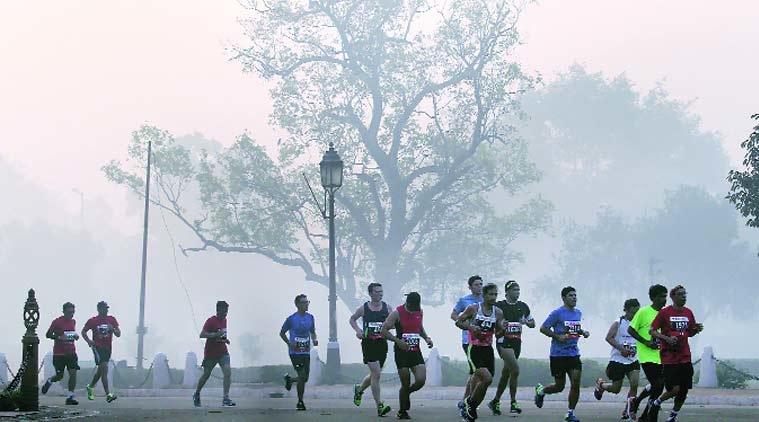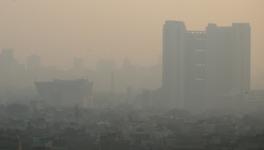Delhi Half Marathon 2017: Personal Records, Yes, But At What Cost?

Immediately after winning the 2016 Airtel Delhi Half marathon Kenya’s Eliud Kipchoge met the assembled media. He talked about the course, and the difficulties he had navigating it. Kipchoge, described by some as the greatest marathoner of the modern era, won gold at the Olympics in Rio earlier in the year. A few months later he attempted to break the two-hour barrier in a marathon in a Nike sponsored race to prove their superiority in racing footwear.
“The first reason that I came here is to run in a city that is polluted, to inspire a whole generation, a country to take up sports,” Kipchoge said. “I came here purely for running in a polluted city. For the past four days that I’m here, I’ve been reading on Twitter about the pollution scare, but I told them it’s not an issue. One of them told me, “I don’t allow my kids to run for more than an hour.” I showed them that it's okay by running for an hour today,” he said.
One would think that this would’ve been enough to shut the critics up. But, on Nov. 8, the Indian Medical Association advised the organisers to cancel the marathon claiming the high pollution levels in the city are ‘risky’ to the runners’ health. The organisers, of course, didn’t cave. The 13th edition of the annual running carnival will go ahead, as planned, tomorrow. The USP of this marathon, after all, is the challenging environment the host city provides. Boston has its hills and climbs, The Inca Trail is notorious for its steep and narrow trails, Delhi’s selling point is simple: If you want to run in pollution, this is it.
Despite what Kipchoge said last year—given the $275,000 pay cheque (in addition to any appearance fee) he probably had to be positive —science suggests running in such an environment can be highly dangerous.
“It’s a catch 22 situation, for a runner in Delhi,” says Hanumant Khanna. Khanna is a graphic designer and an athlete who does triathlons and marathons in his free time. “I was up in the hills for most of the last month so obviously a majority of my training happened in the clean air,” he says. “Here I’ve been training indoors, on a treadmill, which sucks. But it is what it is.” Khanna ran the ADHM last year for the first time and has registered to run it this year too. Ideally, he doesn’t want to do it. But it is, by far, the biggest running event in the city. Most runners, irrespective of their level of seriousness, look forward to the event and use it as an opportunity to set some personal records. Khanna is unsure about attending but grudgingly admits that he probably will.
Harkaran Jassal won’t. The 55-year-old chartered accountant says he never runs this “Airtel Delhi thing”. “The truth,” he says, “is that I train in the city and I don’t train to become an Olympic champion. I train to stay healthy. I run endurance events in Delhi, from March to September, and do a lot of cycling, but this,” he shakes his head vigorously, “No chance.”
“That Kenyan fellow, is an international champion, yaar,” Jassal says. “Just think about it. That fellow will train in the hills or in America in the best places. He has to pay some bills. He has sponsor commitments. He has to run for all that. He’ll probably finish it in an hour (Kipchoge finished in 59:44, 24 seconds shy of the course record set in 2012) and so he will not have to breathe in so much of this polluted air. I will,” he says.
This second point Jassal makes is equally pertinent. The rise of pollution worldwide, combined with the increase in the popularity of running, has raised the question of whether there comes a point at which exercising outdoors is no longer a good thing. Delhi isn’t the only event that faces this criticism. Beijing has regularly had to deal with this noise.
It is well established that regular exercise can improve brain health, and there is growing research suggesting that the brain deprived neurotropic factor (BDNF), a neurotropin, plays a key role in the process. There is also increasing research that exposure to air pollution can have adverse effects on the brain as well as the lungs. Research, easily accessible on the internet, will tell you that in the short term individuals can feel dizzy or breathless. The long-term impact is more serious—leading to lung cancer, heart attacks and other cardiovascular diseases.
Last year, a study published in the journal Preventive Medicine looked at some of the world’s most polluted cities and examined whether the health benefits of outdoor exercise — such as reduced risk of disease, heart conditions and several cancers combined with improved fitness and flexibility — still outweighed the risks of air pollution. Researchers developed computer simulations — based on data from epidemiological studies — to calculate the duration of exercise needed to realise maximum health benefits and the duration of exercise after which the health risks of air pollution outweigh the health benefits (the break-even point). The researchers focused on concentrations of fine particulate matter less than 2.5 micrometres in diameter (also known as PM2.5) — the kind that can penetrate a person’s lungs.
The cities looked at were those with annual average PM2.5 levels between 5 micrograms per cubic meter — close to the lowest PM2.5 level observed in the world at the time — and 200 micrograms per cubic meter, which at the time was far beyond the most polluted city in the world. At the time, Delhi was the most polluted city in the world, with an average PM2.5 level of 153 micrograms per cubic meter (for comparison, Delhi’s PM2.5 levels the day before the race, after the sprinkling of water, was 289).
Overall, the simulations showed that for most cities worldwide, the benefits of exercise outweighed the effects of exposure to pollution. One of the cited examples is that of Durban, South Africa (PM2.5 = 53), where a person could realise the full benefits of exercise after an hour of cycling and would have to cycle four more hours before the pollution began to outweigh the benefits.
In the case of Delhi, researchers calculated that an individual could only the bike ride for 45 minutes in a day, before potentially starting to feel the negative impact of the city’s air. Today, with PM2.5 levels at more than twice what they were when this study was conducted, that time limit no longer applies. While running isn’t explicitly mentioned in the study, (because of the practical difficulties of putting runners through tests) certain parallels can be drawn. Cycling is likely more strenuous on respiration, and therefore cyclists breathe heavier over distances. It is safe to say, what applies to cyclists, applies to runners.
What is for certain is that the Delhi Half Marathon is truly is a race that pushes your limits to the breaking point. Run longer than an hour and a half, and you could be hurting yourself irreversibly. The question each runner needs to ask herself is, “Is a personal best worth all that damage.”
“I’m going to decide whether I’m doing it, literally on the day of the race, depending on how I feel,” Khanna says. “And even then, if I feel like it's not worth it after the first few kilometres, I might quit. It’ll suck. But I will.” From one runner to rest, that might just be the advice worth considering.
Get the latest reports & analysis with people's perspective on Protests, movements & deep analytical videos, discussions of the current affairs in your Telegram app. Subscribe to NewsClick's Telegram channel & get Real-Time updates on stories, as they get published on our website.
























